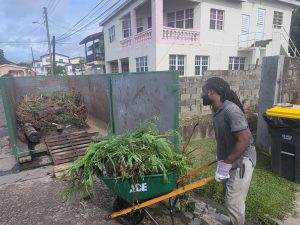National Museum Restoration Project Endangered by Delays, Mismanaged Funds, Abandonment, and Leaks.
The Old Treasury Building in Basseterre, St. Kitts, a structure of immense historical significance and home to the St. Christopher National Trust and Museum, stands as a stark reminder of the devastating consequences of mismanagement and bureaucratic inertia. What began as a promising $1.8 million restoration project in July 2023 has devolved into a protracted saga of delays, financial disputes, and mounting concerns about the irreversible damage being inflicted upon the nation’s heritage. This debacle underscores the critical importance of meticulous planning, consistent funding, and unwavering commitment when undertaking the restoration of historically significant structures.
The restoration project, initially projected to span nine months, was entrusted to Parvenir Restoration, a Trinidad-based firm with a distinguished record, including notable work at Brimstone Hill. Work commenced in September 2023 with the building enveloped in scaffolding and protective hoarding, signaling a hopeful beginning. However, this initial burst of activity proved to be short-lived. Just three months later, the project ground to a halt as the contracting crew returned to Trinidad due to the government’s failure to disburse payments for completed work. This marked the beginning of a prolonged period of uncertainty and neglect, leaving the historic building exposed to the elements and its invaluable contents vulnerable to deterioration.
The financial stalemate persisted for an agonizing seven months, with payments finally resuming in July 2024. However, the full resolution of financial disputes dragged on until February 2025, a full year and a half after the project’s inception. This protracted delay exacerbated the existing structural issues, with reports of a leaking roof and crumbling walls, the latter a consequence of decades-old incompatible repairs. Heritage advocates express grave concerns that the prolonged exposure to these detrimental conditions has caused irreversible damage to the building and its precious contents, representing a significant loss to the nation’s historical patrimony.
The government’s failure to provide timely funding not only stalled the restoration but also placed the museum’s irreplaceable artifacts at risk. Exposed to the elements due to the unfinished repairs, these invaluable pieces of St. Kitts’ history faced the threat of irreparable damage. The situation serves as a stark example of how bureaucratic inefficiency and financial mismanagement can jeopardize a nation’s cultural heritage. The prolonged exposure to moisture and the elements could have caused untold damage to delicate documents, artifacts, and the very fabric of the building itself.
Despite recent assurances from the government and a renewed commitment from Parvenir Restoration to recommence work in April 2025, a palpable sense of skepticism persists. Before restoration can resume, a comprehensive reassessment of the building’s condition is necessary to determine the extent of the damage incurred during the period of neglect. This reassessment will likely lead to revised timelines and potentially increased costs, adding further complexity to an already troubled project. While there is hope that the restoration can be completed by the end of 2025, the prolonged delays and the potential for further complications cast a shadow over the project’s future.
The Old Treasury Building saga stands as a cautionary tale, highlighting the perils of inadequate planning, inconsistent funding, and a lack of urgency in preserving national heritage. This incident goes beyond mere financial implications; it represents a potential loss of a tangible link to the nation’s past. The building is not just bricks and mortar; it embodies the collective memory and identity of St. Kitts and Nevis. Its restoration is not merely a construction project; it is an investment in the preservation of national identity and a testament to the nation’s commitment to its history. The government’s handling of this project has sparked outrage and concern among cultural activists and citizens alike, raising serious questions about accountability and the prioritization of cultural preservation. The hashtag #HeritageAtRisk, circulating on social media, encapsulates the widespread anxiety surrounding the fate of the Old Treasury Building and serves as a poignant reminder of the fragility of cultural heritage in the face of neglect.
Share this content:












Post Comment